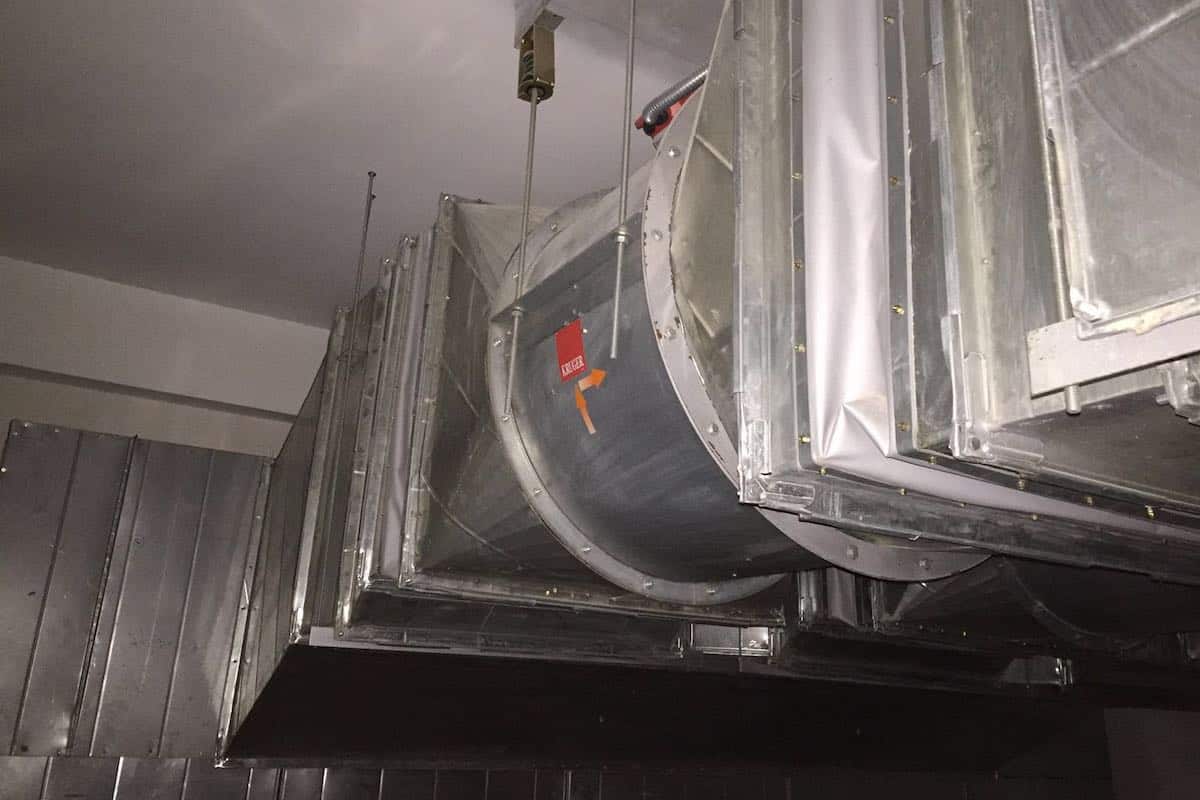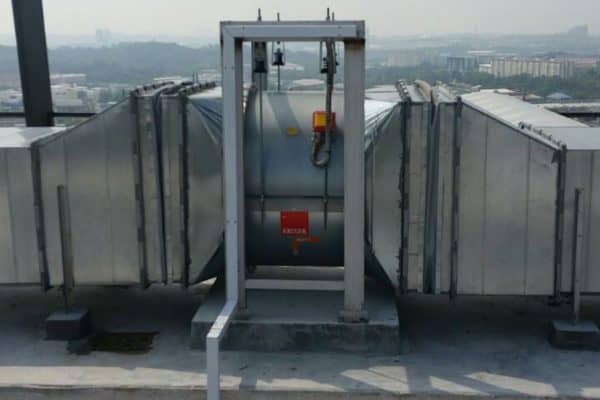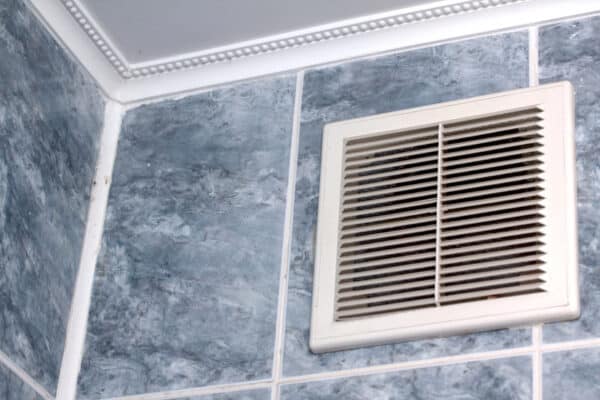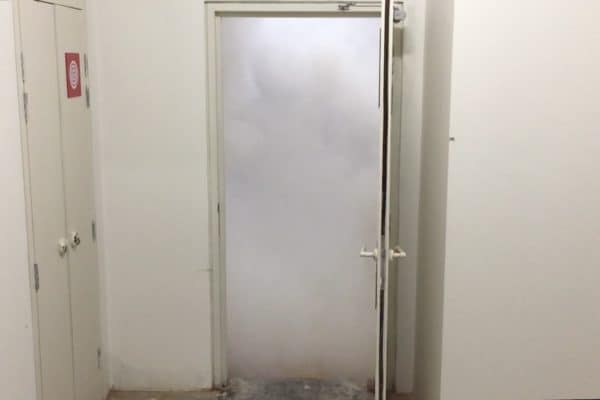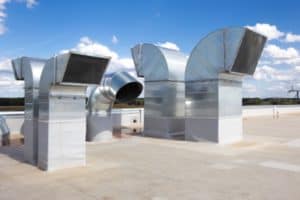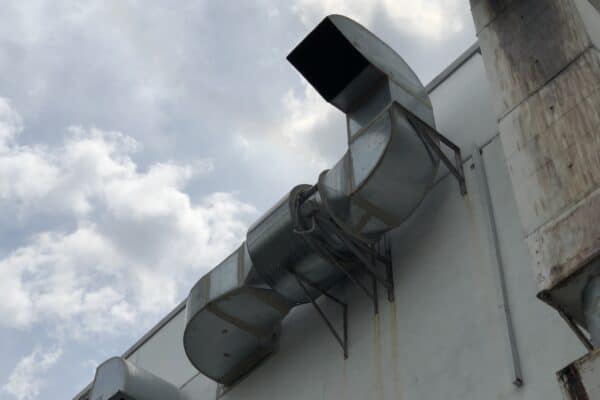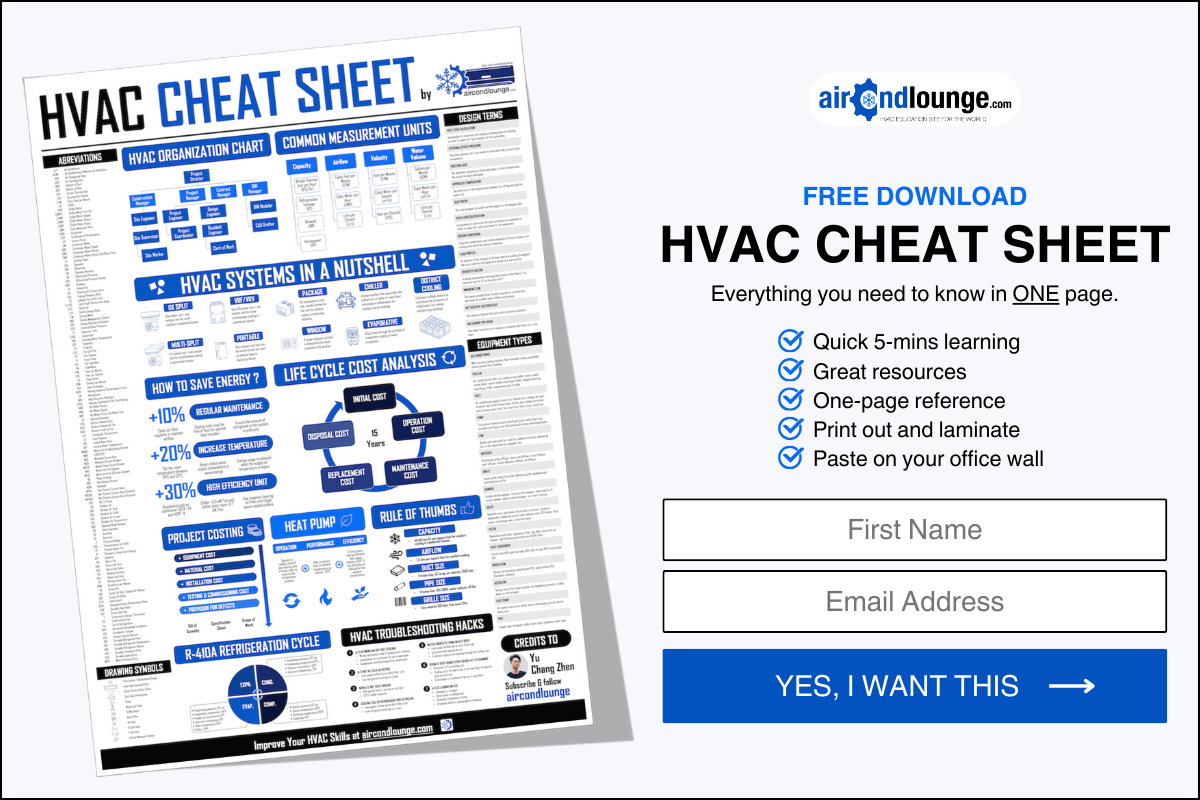Pressurization Fan Duct Connection Basics
Pressurization fans are connected to ducts and a few other components. Each component has its own function to compliment the pressurization system. Let’s look at the basic fan duct connection of the pressurization system and the function of each component.
Pressurization fans draw in outside air, send the air through the ductwork to staircases and lift lobbies to provide pressurization. The pressurization fans are usually located near the exterior wall in dedicated mechanical rooms.
A pressurization fan duct connection starts with a weatherproof external louvre that comes with an insect screen. Then, a plenum box is connected right behind the louvre. Next, a duct reducer connects the plenum box with a fire-rated canvas before it is connected to another duct reducer.
After the duct reducer is the pressurization fan followed by a third duct reducer and a second fire-rated canvas. Then, a non-return damper is sandwiched between the second canvas and the rest of the pressurization ducts.
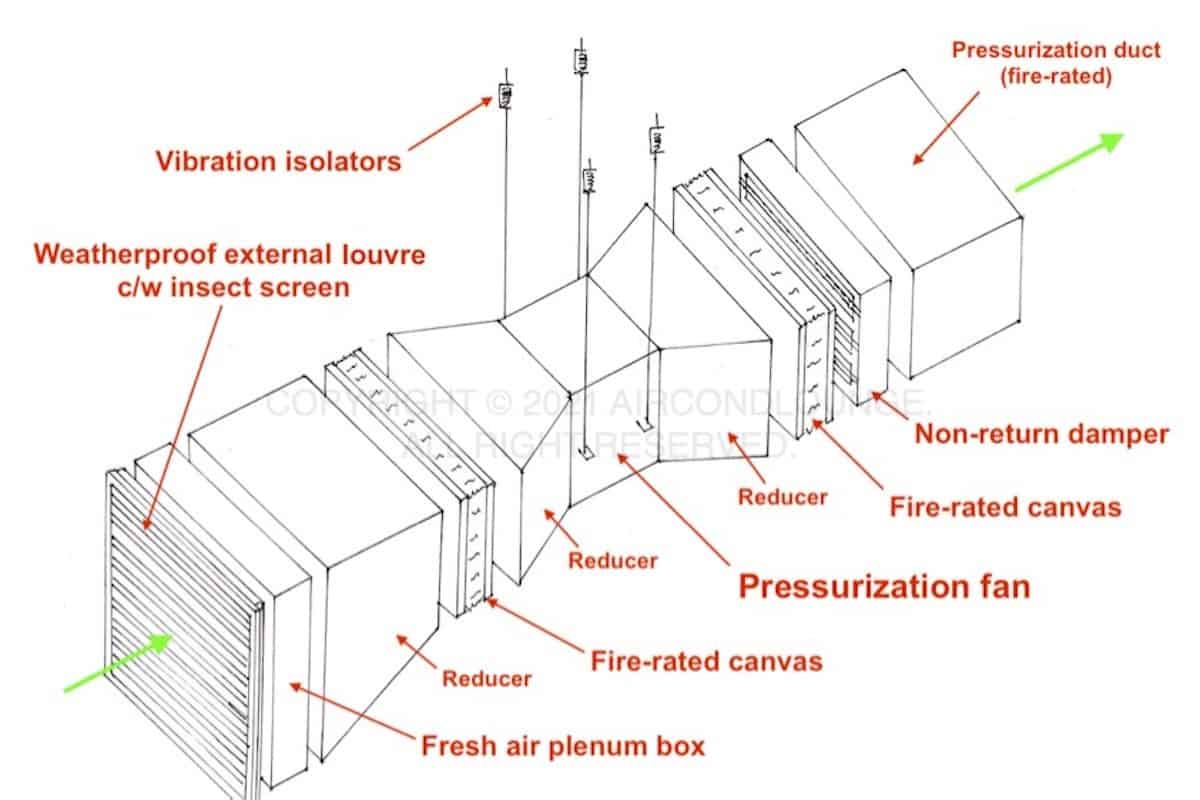
Weatherproof External Louvre
The external louvre installed on the exterior wall of the building must be weatherproof. Weatherproof louvres have narrowly arranged blades and the blade’s profile is designed to prevent rainwater from entering or splashing in.
Typically, weather louvres have an approximately 50% free area despite having such narrowly arranged blades. However, if the required louvre dimension is too large, it is advisable to use multiple louvres instead of one louvre to prevent the louvre blades from bending due to strong suction.
To prevent insects and birds from entering through the external louvre and nesting inside the ductwork, the weatherproof external louvres must have an insect screen. An insect screen basically just a fine steel mesh.
In the meantime, I would like to inform you that you can learn quicker by getting my HVAC Begin (eBook) if you’re a beginner. But, if you have a year or two of experience, then I would suggest you consider my HVAC Basics (eBook). Nonetheless, I encourage you enroll in my HVAC Beginner Course: 10 Days to Become Competent in HVAC if you want to equipped yourself with a complete set of basic HVAC skills.
HVAC Beginner Course
Learn the most basics and foundational HVAC skills including cooling capacity calculation, equipment selection, duct sizing, pipe sizing, exhaust fan sizing, controls, electrical and more.
Plenum Box
A plenum box is attached right behind the external louvre to prevent strong suction that can bend the louvre blades. The plenum box reduces the air velocity at the louvre while maintaining the required air volume. Hence, it reduces the noise at the louvre too.
The plenum box usually is as large as the external louvre with a sufficient depth based on the pressurization fan airflow volume. Insufficient depth will defy the purpose of having the plenum box.
Relevant post: What is a Plenum Box?
Duct Reducers
Duct reducers are used to connect two components of different sizes. As mentioned earlier, we want to reduce the air suction force and the noise at the louvre. So, the louvre and the plenum box are larger than the duct and the fan connection and thus, we use duct reducers to connect them.
Duct reducers collectively create significant pressure drops. Hence, they have a lighter slope to minimize pressure drop. However, we can’t have long duct reducers as they take up valuable spaces. Thus, we need to optimize the duct reducers size based on site conditions and refer to SMACNA duct construction standards for guidance.
When constructing duct reducers, we always put the slope at the bottom rather than at the top. This is because we want to have as much headroom as possible inside the fan room.
Fire Rated Canvas
Pressurization fans bounce a lot during the initial startup. Hence, we need to provide a canvas on both sides of the fan connections to let the fan bounce around and not putting stress on duct joints.
The canvas must be made of fire-rated materials which are normally grey in color while non-fire-rated one is dark green in color. The canvas must have sufficient width so that when the fan bounces, both ends of the canvas will not contact each other which can tear the canvas after a period of time.
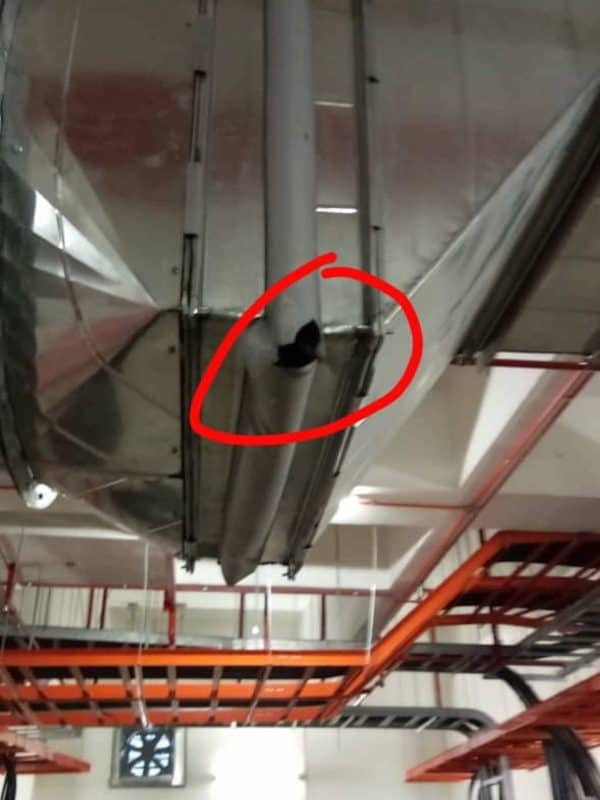
In addition, we must pay extra attention to the integrity of the fire-rated canvas because the canvas sometimes has a few loosen screws which will cause air leakages and reduce the performance of the pressurization system.
Pressurization Fan
The motor of pressurization fans must be fire-rated as well. In Malaysia, we commonly use the class H motor. Many times, it is coupled with a vane axial type of fan.
Most of the time, pressurization fans are hanged from the soffit slab. Vibration isolators must be installed at all mounting points to absorb the vibration caused by the rotating fan blades.
The pitch of the fan blades is adjustable. In case there is a shortfall of airflow volume, you may call the manufacturer to adjust the blade pitch to increase the angle of attack and therefore, increase the airflow volume.
Because the pressurization fan is huge, it has a great amount of inertia. Thus, we must not allow a full-power startup as it put a lot of pressure on the fan blades which may cause them to shatter.
Instead, power is given to the fan in a step-by-step manner. Usually, we use an auto-trans (auto-transformer) starter to break the power into two stages. Initially, the fan starts to rotate slowly at a fraction of the power. After a few seconds, the auto-trans switches and provides full power for the fan to rotate at full speed.
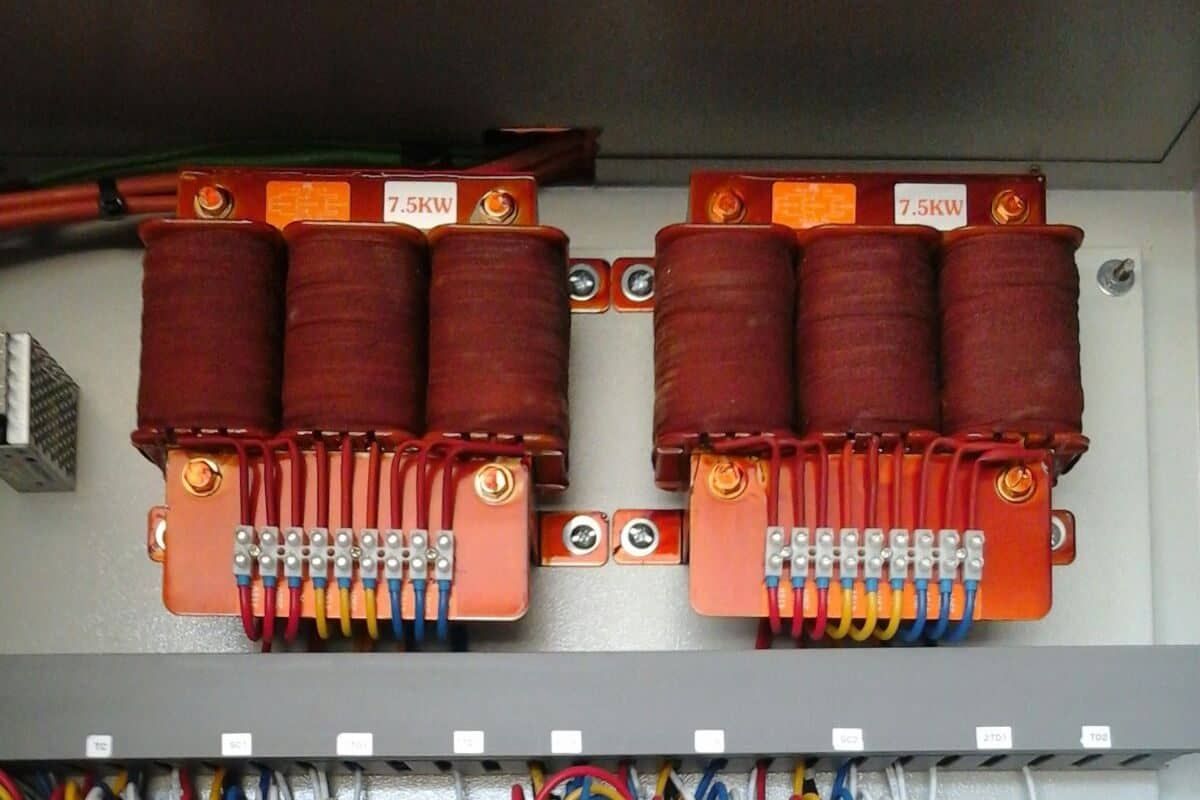
For smaller fans, a star-delta starter is very common while a DOL (direct-online) starter is for even smaller fans like mechanical room ventilation fans.
Auto-trans and star-delta starters also reduce the starting current which greatly helps on the electrical side.
Services such as cable trunking and fire pipes should not run near the pressurization fan because as mentioned earlier, the fan will bounce around during startup and may damage those services.
Non-Return Damper
If you have the main fan and a backup fan, a non-return damper is required for each fan to prevent the air generated by the main fan from going into the backup fan and to the outside.
Non-return dampers only allow a one-direction flow of air. Not only does it prevent birds from entering the building through the ductwork, but it also guides the airflow in the right direction.
Pressurization Duct
All pressurization ducts except those installed inside concrete shafts must be fire-rated. Pressurization ducts must be able to withstand fire for at least 2 hours. The pressurization system stop working even if one small section of the duct falls off.
The airflow is the strongest right after the fan connection. Thus, we should use elbow ducts instead of the square plenum to prevent the air from bouncing back, causing huge pressure drops which may fail the pressurization system.
For pressurization ducts, the duct joints mostly are using the TDC joint. Only small ducts are suitable using the slip-drive joint. However, the TDC joints are prone to air leakages. So, you may need to use sealant to fix the leakages.
Conclusion
The basic duct connection of a pressurization fan consists of a weatherproof external louvre, a plenum box, several duct reducers, two fire-rated canvas, pressurization and a non-return damper. The entire connection is then followed by the rest of the pressurization ductwork.
Weatherproof louvres have narrowly arranged blades and the blade’s profile is designed to prevent rainwater from entering or splashing in. A plenum box is attached right behind the external louvre to prevent strong suction that can bend the louvre blades and reduce the noise at the louvre.
Duct reducers are used to connect two components of different sizes. Since they create significant pressure drop, we need to optimize the duct reducers size based on site conditions and refer to SMACNA duct construction standards for guidance.
Besides, we need to provide a fire-rated canvas on both sides of the fan connections to let the fan bounce around and not putting stress on duct joints.
The motor of pressurization fans must be fire-rated. Vibration isolators must be installed at all mounting points to absorb the vibration caused by the rotating fan blades. Use auto-trans or star-delta starter to reduce the starting current.
If you have the main fan and a backup fan, a non-return damper is required for each fan to prevent the air generated by the main fan from going into the backup fan and to the outside.
Lastly, consider my HVAC Begin (eBook) if you’re a beginner and you want to have a foundational knowledge in HVAC. But, if you have a year or two of experience, then I would suggest you consider my HVAC Basics (eBook). Nonetheless, I encourage you enroll in my HVAC Beginner Course: 10 Days to Become Competent in HVAC if you want to equipped yourself with a complete set of basic HVAC skills.
HVAC Beginner Course
Learn the most basics and foundational HVAC skills including cooling capacity calculation, equipment selection, duct sizing, pipe sizing, exhaust fan sizing, controls, electrical and more.
If you have anything to add (or ask) about this topic, leave a comment down below!


